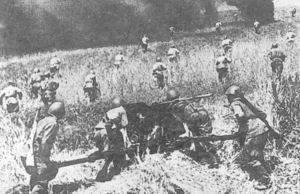



Artillery offensive - fighting artillery in an offensive operation with the aim of reliably suppressing the enemy defenses and continuous support for rifle troops (infantry) and tanks with massive artillery fire .
History of origin
The basics of the artillery offensive based on the experience gained at the fronts were first set forth in the Supreme Command Headquarters Directive of January 10, 1942 . The essence of the artillery offensive was defined in the Combat Regulations of the 1942 Infantry (Part 2):
“The artillery offensive consists in the continuous support of infantry with massive real artillery and mortar fire throughout the entire period of the offensive. Artillery and mortar fire must lead infantry and tanks to attack from one object of defense to another. "
Method Description
When organizing an artillery offensive, decisive mass arming of artillery was envisaged at the breakthrough sites. This achieved superiority over the enemy’s artillery in the direction of action of the strike forces of the fronts and armies . To ensure close interaction with the advancing infantry (tank) units ( formations ) and stable control, the artillery concentrated on the breakthrough sector was united into artillery groups subordinated to the general military commanders . The planning of artillery fire and maneuver by artillery was carried out in the interests of solving the tasks of a combined-arms battle . Based on the nature of the actions of infantry and tanks at different stages of the offensive, the artillery offensive was divided into three periods:
- artillery preparation attacks;
- artillery support attack;
- artillery support for infantry and tank operations in the depths of the enemy defense.
Application
The first experience of organizing and conducting an artillery offensive was obtained at the breakthrough of the 20th army of enemy defenses on the Lama River (during the Moscow Battle of 1941–1942 ). The fully artillery offensive was first carried out in the counteroffensive of the Soviet troops near Stalingrad ( November 19, 1942 ) and from that time it became firmly established in the practice of military operations. Artillery preparation of the attack was carried out by conducting a massive and concentrated fire on the entire tactical depth of the enemy’s defenses (8–10 kilometers or more) in combination with the fire of the guns allocated for firing direct aiming at the targets on the front line . Artillery support for the attack was achieved by successive concentration of fire or a shaft of fire to a depth of 3 to 5 kilometers or more, as well as a combination of these two types of fire. Artillery escort of infantry and tanks in the depths of the battle was carried out by a combination of fire and maneuver escort guns with concentrated fire from artillery groups. The introduction of the practice of artillery offensive marked the transition to higher forms of organization of combat activity of artillery, which became not only tactical, but also operational, which largely determined the outcome of the operation.
“In a well-organized artillery offensive, we saw the embodiment of the power of our army . We believed that everything that we would do with fire instead of a bayonet would be our great advantage and save the troops from unnecessary losses. ”
- Marshal of the Soviet Union I. S. Konev [1]
Eyewitness Descriptions
In his memoirs, one of the participants of the Great Patriotic War describes the artillery offensive as follows:
| Here it is appropriate to briefly explain the concept of "artillery offensive." This term was developed by our military scientists, entered the army vocabulary from the Battle of Stalingrad . Its essence was that before the onset of infantry and tank artillery must suppress enemy defenses, destroy manpower and fire weapons, destroy defenses, disrupt the enemy's fire system and command and control system. These tasks were solved during the artillery preparation of the attack - an integral part of the artillery offensive. The duration of the artillery preparation depended on the nature of the enemy's defense, the availability of his own artillery and ammunition. Its duration could be from several minutes to several hours. In this case, it took more than two hours. All guns fired at the maximum rate in order to quickly disable enemy defenses. During the period of artillery preparation, infantry and tanks under the cover of their artillery fire advance to the line of attack, as close as possible to the front edge of the enemy defenses. After they go on the attack, and the artillery begins the second stage of the artillery offensive - artillery support of the attack, usually it is conducted by the method of a firing shaft [2] |
See also
- Artillery Division Breakthrough
Notes
- ↑ Viktor Vasilyevich Danilov - Junior Sergeant of the Great Patriotic War. Veterans are still in the ranks.
- ↑ Novokhatsky I. M. Memoirs of the battery commander. - M .: Tsentrpoligraf, 2007. - ISBN 978-5-9524-2870-6 .
Literature
- Artillery offensive // Great Patriotic War, 1941-1945 : encyclopedia / ed. M.M. Kozlov . - M .: Soviet Encyclopedia , 1985. - p. 65. - 500 000 copies.